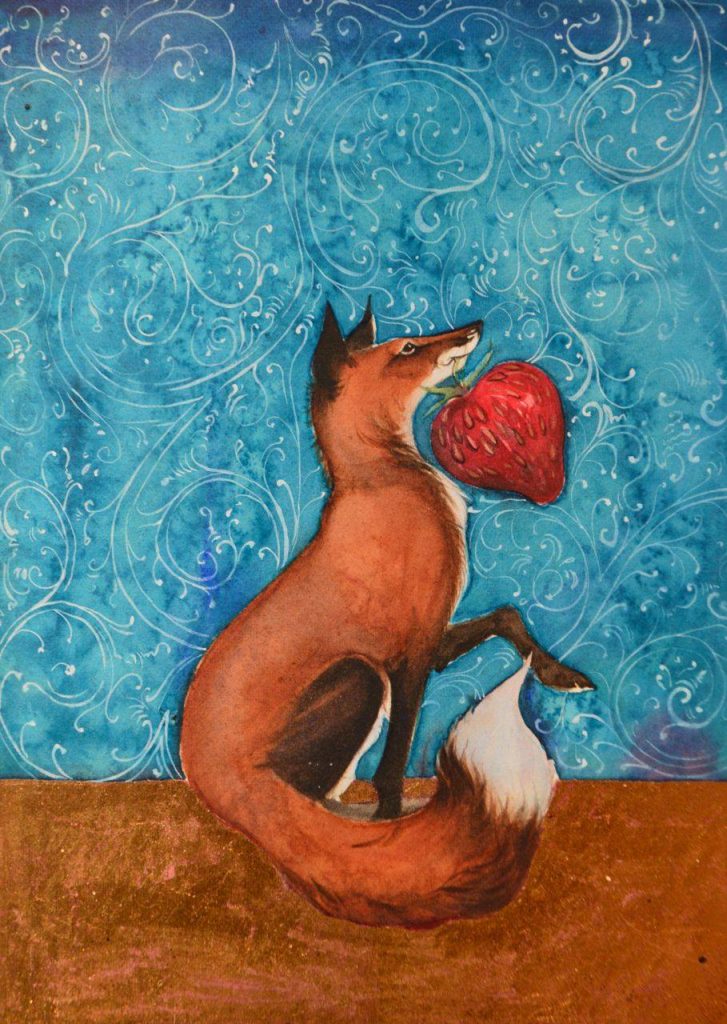
This is a tale told on frescoed plasterwork, once hidden by whitewash and restored with care…
People came into the the old chapel, eager to escape the summer heat . The old walls gave off calm and coolness. As they all waited for the Pilgrim Woman to start the story that would pay her rent, a farmworker looked closely at the walls.
‘Look,’ he said in heavily accented English, ‘There is a picture of Our Lady and the Christ Child. She’s gives him a strawberry, yes?’
‘Yes,’ said another, dusty-skirted with her walk from Sidlesham,’ – and there’s a fox at her feet. I wonder why?’
The Lord-by-the-Sea came and sat in his chair. He nodded, too hot to talk. The Pilgrim Woman began her story:
“When the Christ-child was a mere babe, he suffered with his teething like every small child. His Mother Mary grew distraught to see her beloved son suffer, putting his fingers on his gums and weeping. Everyone she asked gave her remedies – but none worked.
At last, she went to visit a wisewoman in a wood. She left the Christ-child with her dearest cousin Elizabeth. He played peaceably with his cousin John even though his gums were sore and red.
The wisewoman was known for her healing, and her shyness. Yet when Mary came to her door, she had it open before she knocked, and greeted her with open arms.
‘What brings the Blessed Mother to my door? Come in and tell me all.’
The wisewoman listened to Mary’s concerns over tea. Then she sat thoughtfully for a while.
‘I can help your son – but it will bring pain to you. Shall I continue?’
Mary nodded eagerly.
‘I would carry all his pain if I could.’
The wisewoman picked up a basket and gave it to Mary.
‘Go into the woods and seek for fruit. The first one that nature guides you to will be the cure.’
Mary turned to go. The wisewoman took hold of her arm gently.
‘Be warned. That fruit will tell me your future – and I must speak it.’
‘So be it,’ said Mary.
The woods rang with birdsong. Sunshine lit a path through the trees and butterflies danced around each other in the warm air. Mary followed them. Along the way, a fox trotted about its business. In those days, it was the shyest of creatures – yet it did not flee Mary. It paced onwards until Its glorious tail brushed against a patch of white further the turned off the path.
Mary went to see what it might be. Surely not snow?
A patch of five petalled blossoms grew at the edge of the trees. She bent down to look at their dainty shapes.
Praise be for little wild-flowers she said in her heart and knelt down. She parted the leaves to see the flowers better. Tiny red fruits glistened underneath; juicy little berries lying on the straw left behind by last year’s grass. Their smell filled her thoughts with sweetness.
‘Ah,’ she said in joy and thankfulness, ‘these are a blessing from the earth.’
Back at the wisewoman’s house, Mary showed the seeress her fruit. The wisewoman smiled and bowed. With a sharp knife, she cut one of the berries in half. Then she held it out on her palm.
‘This heart shape, sweet and pink to the very core is your nature: soft and filled with love. How easily it bruises.’
She closed up the berry and pointed at the dimples in its skin. Hundreds of tiny spots sat in them clustered close together like raindrops.
‘See these seeds? These are the tears you will shed for your beloved son.’
Then she ruffled the circle of green leaves on top of the fruit.
‘And this is the crown you will win in Heaven.’
Mary treasured these sayings in her heart. She thanked the wisewoman and went back to her son with the strawberries. And from that day to this a cooled strawberry has been a sovereign remedy for crying children.”
Picture used with kind permission of Jackie Morris. Story written especially for Kathryn Evans as part of the #tommyvcancer campaign.

Philippa, you made me cry – beautiful – and Jackie, glorious as ever xxx
Thought it might. Like the best work I do, straight from the Divine Muse. Jackie is a wonder.